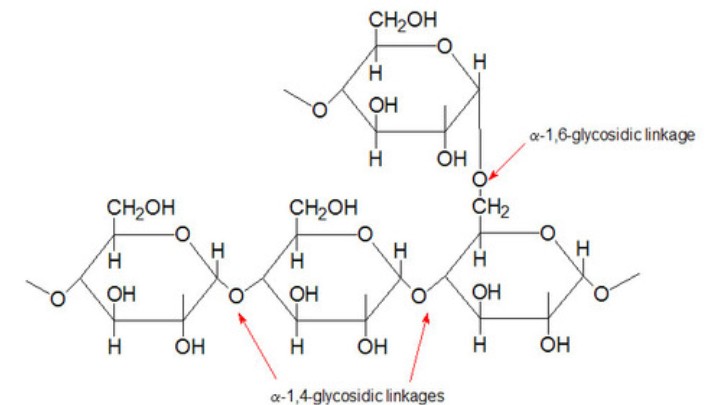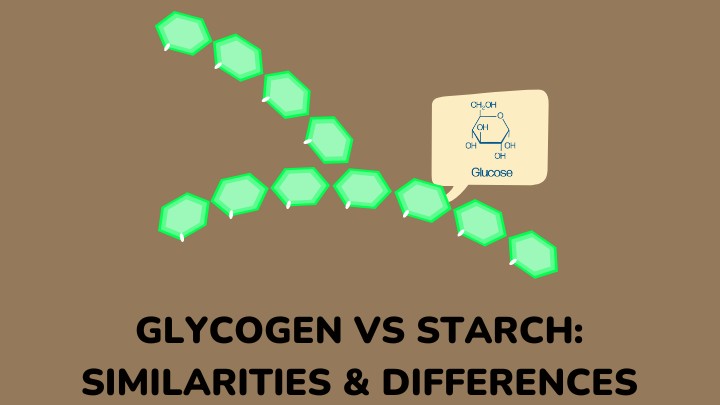Energy is stored predominantly in two types of polysaccharides, namely: glycogen and starch. These two energy storage are often mistaken for each other because they do share some similarities amid their differences.
To help you differentiate them correctly, I have put together a comparison of glycogen vs starch.
One of the first things to remember when you are asked to make a comparison of glycogen vs starch is, that glycogen is the energy storage polysaccharide in animals, and starch is the polysaccharide in plants. Yes, that is why cassava, tapioca, rice, and corn are “starchy”.
Read on to see how I concisely differentiated glycogen from starch.
What is glycogen?

Glycogen is the storage form of glucose present in animals and fungi. It is a complex polysaccharide made of glucose units linked together by alpha-glucose linkages. It is also known as animal starch.
The starch animals consume from plants is stored up as glycogen. Under certain physiological conditions in which the body requires oxygen, glycogen is broken down into glucose units via a pathway known as glycogenolysis. This process is triggered by an enzyme called glycogen phosphorylase.
Conversely, when blood glucose levels increase, hexokinase (HK), glucokinase, and glycogen synthase work together to synthesize glycogen from the glucose in the blood.
Furthermore, glycogen is not primarily sourced from food. That is, there are no “glycogen-rich” foods.
However, you can enhance glycogen synthesis when you consume foods such as rice, barley, pasta, cereal, pasta, legumes, spinach, broccoli, zucchini, and fruits like bananas, blueberries, and cantaloupes.
In addition, glycogen storage diseases (GSDs) are a class of hereditary diseases caused by a gene mutation that disrupts the way the body stores and uses up glycogen. They may manifest as low blood sugar, liver damage, and muscle weakness.
What is starch?

Starch is a storage form of glucose in plants. It is a complex polysaccharide of glucose units connected by alpha-glucose linkages. Starch is made up of two polymers, namely; amylose and amylopectin.
Starch comes from the photosynthetic process green plants carry out to produce food and energy. Plants use starch to produce cellulose (a structural polysaccharide) and proteins under certain conditions.
Starch is present in many staple foods, such as potatoes, fruits, rice, wheat, corn, and cassava.
Amylose and amylopectin are two different polymers. Amylose, a linear and helical chain polymer makes up 25% of plant starch. The remaining 75% is made of branched-chain amylopectin. The reaction between these two chains under heat is what brings about the ability of starch to form a paste.
Glycogen vs starch: Similarities
- Both are complex polysaccharides that comprise glucose units
- They are branched polymers of glucose units joined by alpha-glucose linkages called glycosidic bonds
- Glycogen and starch are stored in living things in the form of granules
- Starch is the energy storage polysaccharide in plants. When animals consume this starch, the glucose units are stored up as glycogen in muscles and several other parts of the body
Glycogen vs starch: Differences
Structure
Glycogen is a highly branched polysaccharide. Starch consists of two polymers: amylose and amylopectin. Amylose is a coiled straight-chain polymer and amylopectin is a branched-chain polymer that comprises coiled and uncoiled chains.
Although both polysaccharides have glycosidic bonds, the bonds are slightly different in both because of amylose in starch. Amylopectin is a simple glycogen chain.
The glucose units in amylose are linked together by α-1,4 glycosidic bonds while amylopectin consists of α-1,4 and α-1,6 glycosidic bonds. Glycogen is made of only one polymer with both α-1,4 and α-1,6 glycosidic bonds.
Furthermore, glycogen is more branched than amylopectin. The branches in glycogen occur at every 8-12 glucose units while the branches in amylopectin occur at every 20 glucose units.
Another point worth noting is the molecular formula of both polysaccharides. The molecular formula of starch is (C6H10O5)n, while the molecular formula of glycogen is C24H42O21.
Localization
Starch is stored as granules in the chloroplasts of plants. It is also present in storage organs, such as tubers of potatoes, roots of cassava, and in the seeds of rice and corn.
Glycogen is stored in the liver and muscle of animals and humans.
Functions
To start with, glycogen is the energy-storage polysaccharide in animals, while starch is the energy-storage polysaccharide in plants.
Glucose taken from the body is stored up as glycogen, which becomes a source of energy when demand arises.
During exercise, glycogen in the muscle breaks down into glucose to provide energy for muscle contractions. Glycogen breakdown also occurs in times of stress, fasting, and fight- or flight-responses.
Starch is an alternative source of energy for plants when the photosynthetic process is inactive. It supplies the plant with energy for growth, development, and reproduction. Starch is also an important component of many plant cell walls, providing support and rigidity.
Furthermore, glycogen storage in the liver helps to regulate blood sugar levels. Under normal physiological conditions, insulin release triggers the removal of excess glucose from the blood and stores it up as glycogen.
When blood glucose levels drop again, glycogen breaks down into glucose. These two processes help to prevent hyperglycemia and hypoglycemia.
Back to starch, this carbohydrate also supports seed germination and early growth. During development and when plants have not developed their leaves and roots, the embryo depends on the starch storage for food and energy.
Also, starch accumulation in the chloroplasts of green plants helps to protect cell structures from any damage cold temperatures can cause.
Glycogen is also beneficial to some bacteria. These bacteria use their glycogen storage to carry out osmoregulation, an important process that helps them survive in periods of low water availability.
Beyond biological importance, starch finds application in paper, food, textile, and pharmaceutical industries. Its ability to thicken, form gels, and enhance texture makes it valuable.
Pharmaceutical companies use it as a binder in the wet granulation process of massing and screening in the production of tablets and capsules.
FAQs
What is the difference between starch, glycogen, and fiber?
Starch, glycogen, and fiber are complex carbohydrates. They are all composed of glucose units. However, the difference between them is in their digestibility and structure.
Fiber is a constituent of resistant starch, and the body does not easily break it down. Starch and glycogen are energy-storage polysaccharides in plants and animals, respectively.
What is the difference between starchy and fibrous carbs?
Fibrous carbs contain more dietary fiber than starchy carbs. Foods rich in this dietary fiber tend to keep you feeling full for long periods because they digest slowly. Also, they are beneficial to digestive health.
Unlike starchy carbs, fibrous carbs do not cause weight gain because they are not readily converted to fats. Also, fibrous carbs have more nutritional value than starchy carbs because they are present in vegetables and fruits, which also provide the body with vitamins and minerals.
Some examples of starchy carbs are oatmeal, brown rice, couscous, cream of wheat, whole wheat bread stix, whole wheat waffles, pretzels, pasta salad, and bananas.
Fibrous carbs include broccoli, tomatoes, fresh apples, grapes, blueberries, mushrooms, squash, zucchini, peach, pear, and onions.
What is the difference between starch, cellulose, and glycogen?
The major difference between starch, cellulose, and glycogen is their purpose. Glycogen and starch are storage polysaccharides, but cellulose is a structural polysaccharide.
Also, glycogen is present in animals, but starch and cellulose are present in plants. Moreover, glycogen and starch are branched chain polymers of 𝜶-glucose units, while cellulose is a straight chain polymer of 𝛃-glucose units.
Conclusion
Glycogen and starch are made of glucose units and are energy storage forms in living things. Some other similarities are the alpha-glucose linkages that link two glucose units, the branched structures, and their importance in nutrition.
Although glycogen does not directly have dietary importance to man, it contributes to the nutritional value of many carbohydrates. Glycogen and starch are also quite different in structure, composition (beyond glucose units), branching, and digestibility.
From this glycogen vs starch comparison, you can see that these two polysaccharides differ in the same areas of their similarities.
I recommend that you learn about the structure, functions, and food sources of the non-essential amino acids.
Thanks for reading.
